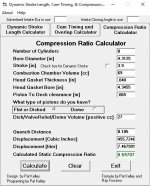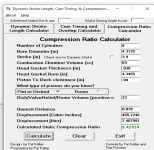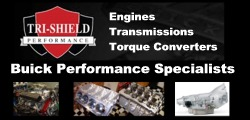About a decade ago I picked up a very nice running rusty 76 Riviera with 455 and slipping 400th. Was going to do a quicky install of the motor in a 65 A body, but later I got a pretty good offer on that car and sold it. 455 is all cleaned up and pretty, but not fully assembled and has been a garage window decoration ever since. All dressed up and no place to go..
It has been turned once in a while to keep it loose. I had also picked up an aftermarket 455 billet flywheel, clutch, NOS Lakewood BOP bell, and pulled a Super T10 out of another car I parted (3 groove input shaft). All that stuff was going on the 455 on a low budget build.
Being too busy at the time to work on the motor myself, I had paid a young reasonably competent mechanic neighbor to pull the motor and install a TA moderate upgrade cam and lifters, replace the timing chain and intake. Forgot what grind cam I bought, but it was beyond stock - though nothing extreme being a low CR was still anticipated.
While the motor was being worked on though, I bought a set of reconditioned 1231786 heads from a guy who went to aluminum heads. They are the standard valves, not the stage 1. But they have the smaller chambers than the 76 heads. Also picked up a good used Offy 360 intake to lighten it a bit. So, the motor then came further apart than originally anticipated.
Long story, but the mechanics life fell apart and he never finished it, so I got it back partially together. The 1970? heads and aluminum Offy 360 intake are just sitting on it with a couple bolts. I have a few boxes of parts here to reinstall, and to add to the confusion I have a 2nd bunch of parts from a 73-74 455 that I bought disassembled and someone then bought that extra short block and heads. Those 73-74 parts are now co-mingled with the 76 parts.
So, not sure if there is any difference between timing covers, rockers, shafts, pushrods, etc.. But I have two later years (73-74? and 76) versions of all of them in boxes and not sure what belongs to which motor any more. Still have the new set of lifters for the new cam and a double roller timing chain amongst the parts.
The now long ago moved out of state mechanic neighbor said my timing cover was OK and he had done Buick motors previously and knew about the wear factor on timing cover that affects oil pressure, so maybe I am worrying about that needlessly. But, I never really knew what to look for regarding the timing cover and oiling issues.
But, now I want to finish assembly of the 455 and swap it into a 50's car that has a stuck SBC in it currently. The motor weight should be similar given the aluminum intake and swapping the heavy cast manifolds for headers. I have done multiple engine rebuilds on Chev, Ford and Mopar engines, but never a Buick.
Probably have done enough engine swaps that the mounts won't be an issue and I have a modestly used set of Ken Belle 455 headers I can modify if needed for exhaust. Don't think the Buick pan will interfere with the steering. Going to still try to keep this on the cheap though and not get carried away going through the whole engine as I tend to do every time.
But, I have some questions:
What CR is the likely result of 76 pistons and 70 head? About 12cc chamber difference I read in some places; 6-7cc difference I read other places...
Using a composition head gasket, but didn't 76 use a composition gasket anyway?
Any way to estimate hp and torque from this combo of block and heads with moderately upgraded cam?
The oil passages complication when swapping to older heads..... Applies to 1970 heads? Some places I read you should plug block oiling holes, other places I read you should plug head oiling holes... Which applies to this combo?
What to look for on infamous potential oiling issues?
Do I need to do anything with whichever timing cover I use?
I will probably keep the 76 HEI distributor. Do I need to change weight springs or anything?
Did Buick go through the same changes as Ford during that era, where depending on what year timing gears you use, that they retarded the cam on the newer engines of the era?
Would think using the aftermarket roller timing sets would prevent that happening, but idk. I got a Lunati degree wheel recently, but have not used it yet.
Thanks for any input and suggestions you can offer from your experiences with these motors.
It has been turned once in a while to keep it loose. I had also picked up an aftermarket 455 billet flywheel, clutch, NOS Lakewood BOP bell, and pulled a Super T10 out of another car I parted (3 groove input shaft). All that stuff was going on the 455 on a low budget build.
Being too busy at the time to work on the motor myself, I had paid a young reasonably competent mechanic neighbor to pull the motor and install a TA moderate upgrade cam and lifters, replace the timing chain and intake. Forgot what grind cam I bought, but it was beyond stock - though nothing extreme being a low CR was still anticipated.
While the motor was being worked on though, I bought a set of reconditioned 1231786 heads from a guy who went to aluminum heads. They are the standard valves, not the stage 1. But they have the smaller chambers than the 76 heads. Also picked up a good used Offy 360 intake to lighten it a bit. So, the motor then came further apart than originally anticipated.
Long story, but the mechanics life fell apart and he never finished it, so I got it back partially together. The 1970? heads and aluminum Offy 360 intake are just sitting on it with a couple bolts. I have a few boxes of parts here to reinstall, and to add to the confusion I have a 2nd bunch of parts from a 73-74 455 that I bought disassembled and someone then bought that extra short block and heads. Those 73-74 parts are now co-mingled with the 76 parts.
So, not sure if there is any difference between timing covers, rockers, shafts, pushrods, etc.. But I have two later years (73-74? and 76) versions of all of them in boxes and not sure what belongs to which motor any more. Still have the new set of lifters for the new cam and a double roller timing chain amongst the parts.
The now long ago moved out of state mechanic neighbor said my timing cover was OK and he had done Buick motors previously and knew about the wear factor on timing cover that affects oil pressure, so maybe I am worrying about that needlessly. But, I never really knew what to look for regarding the timing cover and oiling issues.
But, now I want to finish assembly of the 455 and swap it into a 50's car that has a stuck SBC in it currently. The motor weight should be similar given the aluminum intake and swapping the heavy cast manifolds for headers. I have done multiple engine rebuilds on Chev, Ford and Mopar engines, but never a Buick.
Probably have done enough engine swaps that the mounts won't be an issue and I have a modestly used set of Ken Belle 455 headers I can modify if needed for exhaust. Don't think the Buick pan will interfere with the steering. Going to still try to keep this on the cheap though and not get carried away going through the whole engine as I tend to do every time.
But, I have some questions:
What CR is the likely result of 76 pistons and 70 head? About 12cc chamber difference I read in some places; 6-7cc difference I read other places...
Using a composition head gasket, but didn't 76 use a composition gasket anyway?
Any way to estimate hp and torque from this combo of block and heads with moderately upgraded cam?
The oil passages complication when swapping to older heads..... Applies to 1970 heads? Some places I read you should plug block oiling holes, other places I read you should plug head oiling holes... Which applies to this combo?
What to look for on infamous potential oiling issues?
Do I need to do anything with whichever timing cover I use?
I will probably keep the 76 HEI distributor. Do I need to change weight springs or anything?
Did Buick go through the same changes as Ford during that era, where depending on what year timing gears you use, that they retarded the cam on the newer engines of the era?
Would think using the aftermarket roller timing sets would prevent that happening, but idk. I got a Lunati degree wheel recently, but have not used it yet.
Thanks for any input and suggestions you can offer from your experiences with these motors.






